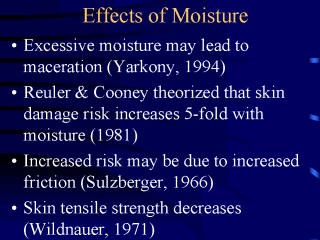 |
Moisture, along
with temperature and the mechanical factors previously mentioned, appears to be another
key extrinsic factor in pressure ulcer development. The sources of skin moisture that may
predispose the skin to breakdown include perspiration, urine, feces and fistula or wound
drainage. Excessive moisture may lead to maceration . Reuler & Cooney theorized that
one's risk of skin damage increases fivefold in the presence of moisture . Increases may
be due to the slight increase in friction that occurs with light sweating or to the
increase in bacterial load resulting when alkaline sources of moisture neutralize the
protection provided by the normal acid mantle of the skin. The detrimental effect of an
increase in moisture adjacent to the skin has been demonstrated by tensile tests on
excised skin strips in a controlled humidity environment. In Wildnauer's study, the
tensile strength of the strips decreased 75% with an increase in relative humidity from
10% to 98% . Skin with such reduced strength may be more prone to mechanical damage from
shear stress or abrasion. |
